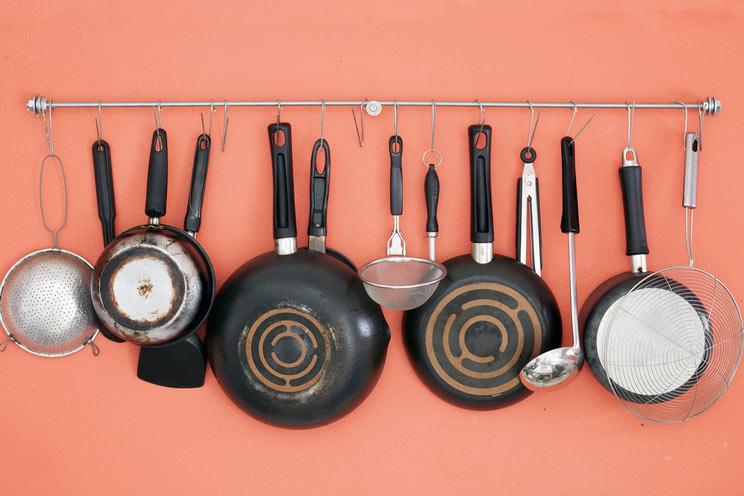While most pots and pans look and feel the same, a lot of cookware leaches the chemicals they’re made from into the food you’re cooking. Yikes.
You’ve switched to all-organic food, bought water filters, gotten rid of toxic household cleaners, and started recycling.
Life should (at least in your home) be pretty much toxin-free at this point, right? Unfortunately, there’s one more toxin source that could be lurking right under your nose: your cookware.
Cookware might seem like an innocent bystander in the world of toxin and chemical exposure. After all, most pots, pans, and utensils look and feel the same, and hardly seem as if they’re giving off toxic fumes. In fact, some of them might even be a cherished part of your cooking routine. (Who doesn’t love that amazing non-stick pan that leaves not a speck of egg behind after frying?)
While this is understandable, the problem lies in the fact that cookware leaches the chemicals they’re manufactured from into the food you’re cooking. And these chemicals are anything but safe, with many even being cancer-causing.
10 Toxins in Cookware and Why You Need to Get Rid of Them
Before we get started on how to avoid these chemicals while still being able to enjoy cooking, let’s first have a look at the toxins we’re dealing with in cookware.
1. Aluminum
Aluminum is the third most abundant mineral in the Earth’s crust, found throughout our water, air, and soil. The fact that there’s so much of it makes it ideal for manufacturing a high amount of cookware, while still keeping the prices low.
While purchasing aluminum cookware is undoubtedly attractive from a money-saving standpoint, the consequences of doing so are more than a little scary. Aluminum is a soft, highly reactive metal, and while naturally abundant in the Earth, has serious health effects when ingested. In fact, aluminum is a known neurotoxin that researchers estimate inhibits more than 200 biologically important functions in your body.
Additional studies link excessive aluminum exposure to Alzheimer’s disease and dementia, while others have shown it causes nervous system damage.
2. Teflon (PTFE)
Teflon, commonly known in the kitchen as “non-stick” or as polytetrafluoroethylene in the lab, is one of the most toxic chemicals you’ll find lurking in your kitchenware. In studies, Teflon has been shown to release at least six toxic gases when heated, with several of those being carcinogenic. One, called monofluoroacetic acid, is known for being lethal even at small dosages, while another referred to as PFIB, is a chemical analog of the WWII nerve gas phosgene.
3. Perfluorooctanoic acid (PFOA)
PFOA is another non-stick chemical used in the manufacture of Teflon. Like PTEE, it has also been linked to nasty side effects such as the development of tumors, neonatal death and toxic effects on the immune system, liver, and endocrine system. PFOA also has a half-life of three years and is not metabolized by the body, meaning once it’s in you (as it is in most humans living in industrialized nations) it’s there for a long, long while.
4. Copper
Copper cookware has been prized by many a cook for decades due to its ability to heat quickly and evenly. However, copper is extremely susceptible to leaching into foods, especially when exposed to acidic foods, like tomato sauce. While some copper is healthy, overconsumption has been linked to the development of ulcers and liver damage.
5. Cadmium
Some companies use glazes and coatings on their cookware to give them a uniform color and more balanced heating abilities. Unfortunately, these coatings often contain cadmium, one of the most toxic metals in our environment. It is a known human carcinogen and tends to build up in the kidneys and liver over time, where it can remain for several years.
6. Nickel
Like cadmium, nickel is used in glazes and linings of pots and pans, and can even be found in some stainless steel cookware. While it does occur naturally in the environment, excessive exposure has been linked to dermatitis and lung and nasal cancers when inhaled. It has also been shown to cause nausea and vomiting, as well as neurological effects.
7. Lead
Some ceramic, enamel, and glass cookware is made with lead in order to increase shock resistance (aka, reduce the chance of it breaking if you set it on the counter a little too hard) and improve glossiness. Unfortunately, (as most of you are now aware of), lead is highly toxic and can cause symptoms ranging from muscle soreness and colic to peripheral neuropathy and renal failure.
8. BPA
Bisphenol-A is a synthetic compound found in plastics like cutting boards and tupperware. You have probably come across a number of cans and containers labeled “BPA-free” in the past few years due to rising awareness of its dangerous side effects.
For one, BPA is an endocrine disruptor. This means that it disrupts your hormones and can lead to altered immune function, early puberty, infertility, and ovarian dysfunction. In addition, BPA has also been shown to cause liver damage, thyroid damage, and obesity-promoting effects.
9. Polystyrene
It turns out other kitchen items beside your pots and pans are potentially far from safe as well. Plastic cups, styrofoam cups, “paper” plates and plastic utensils are almost all made with a toxic compound called polystyrene (or simply “styrene”). Studies involving workers’ exposure to polystyrene experienced changes in color vision, tiredness, feeling drunk, slowed reaction time, concentration problems, and balance problems, while animal studies showed hearing loss and liver damage.
10. Brominated flame retardants (BFRs)
As any egg-scrambler knows, you can’t cook much without utensils like spatulas. Unfortunately, these plastics are usually coated in brominated flame retardants (BFRs) that have been linked to liver and thyroid damage, as well as negative changes in the kidneys.
Originally posted at paleohacks.com

